Why you can trust Tom's Hardware
Our standard benchmarks and power tests are performed using the CPU’s stock frequencies (including stock Thermal Velocity Boost), with all power-saving features enabled. Optimized defaults are set in the BIOS and the memory set using the XMP profiles. For this baseline testing, Windows is set to High Performance before we switch over to Balanced during power testing, so the PC idles appropriately.
Synthetic Benchmarks
Synthetics are a great tool to figure out if a board runs out of spec, as identical settings should produce similar performance results. Advanced memory timings are the one place where motherboard makers can still optimize for either stability or performance, though, and those settings can impact some testing.


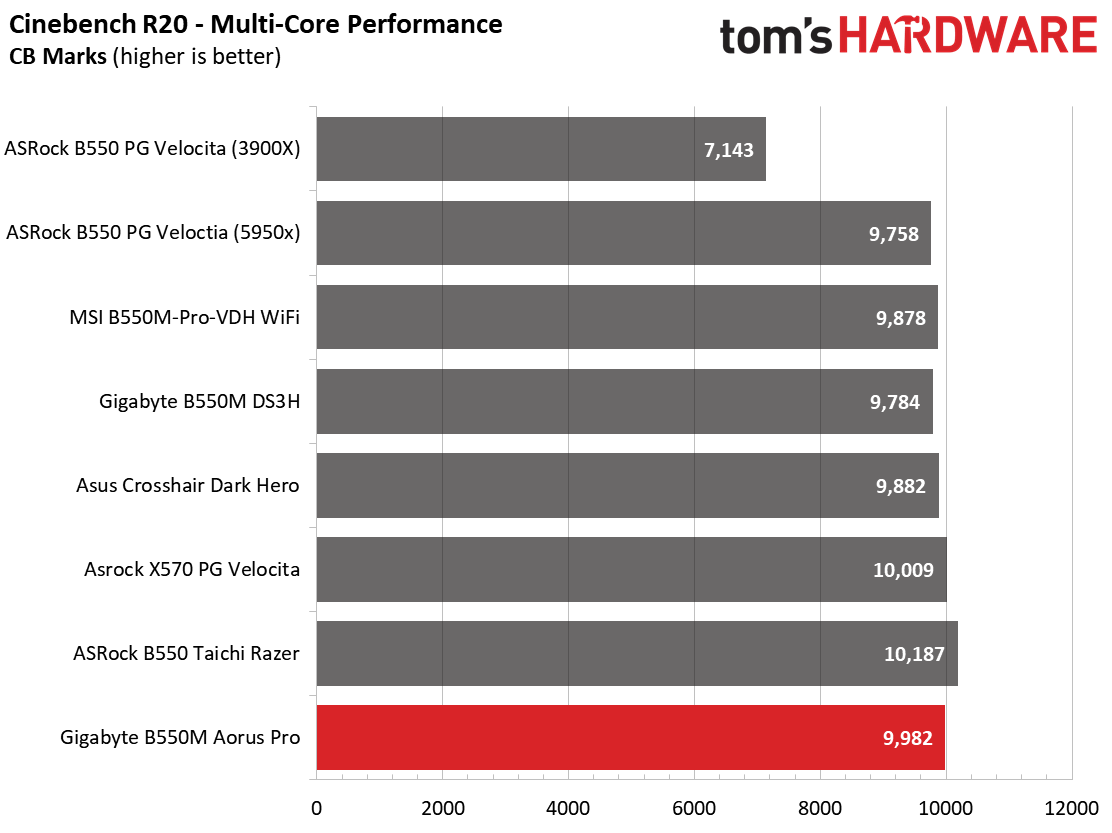





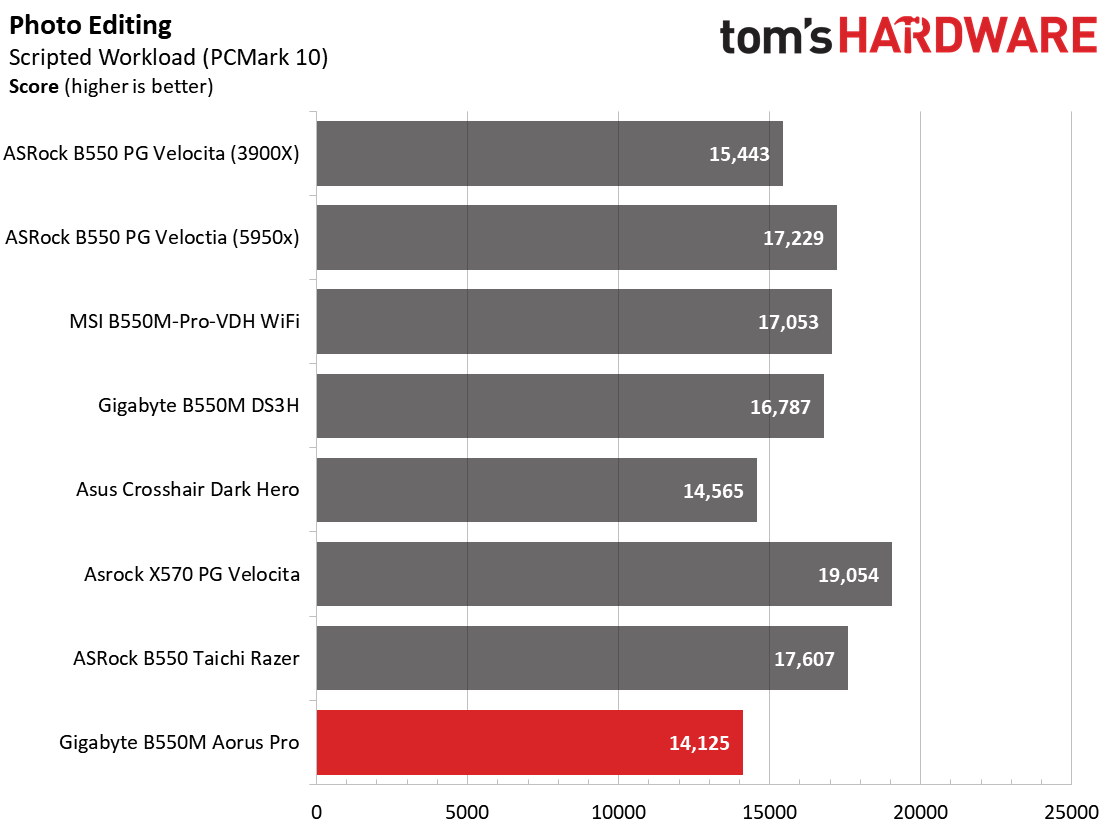
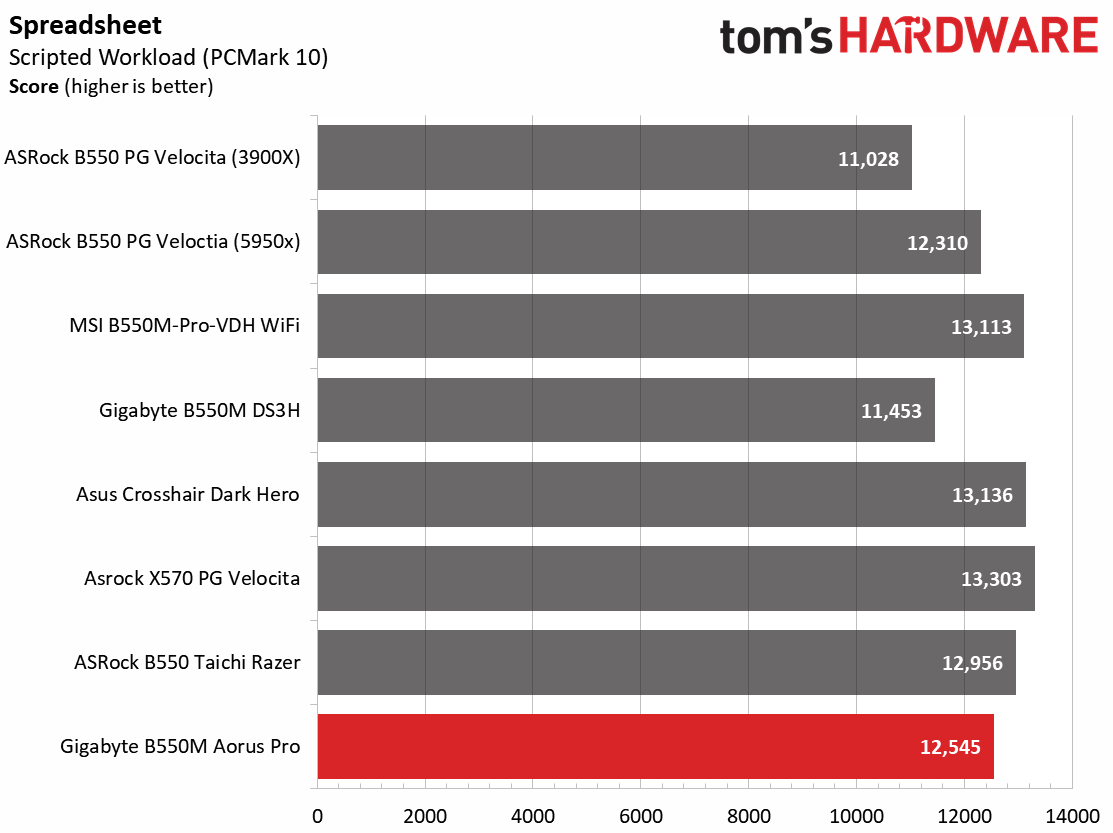

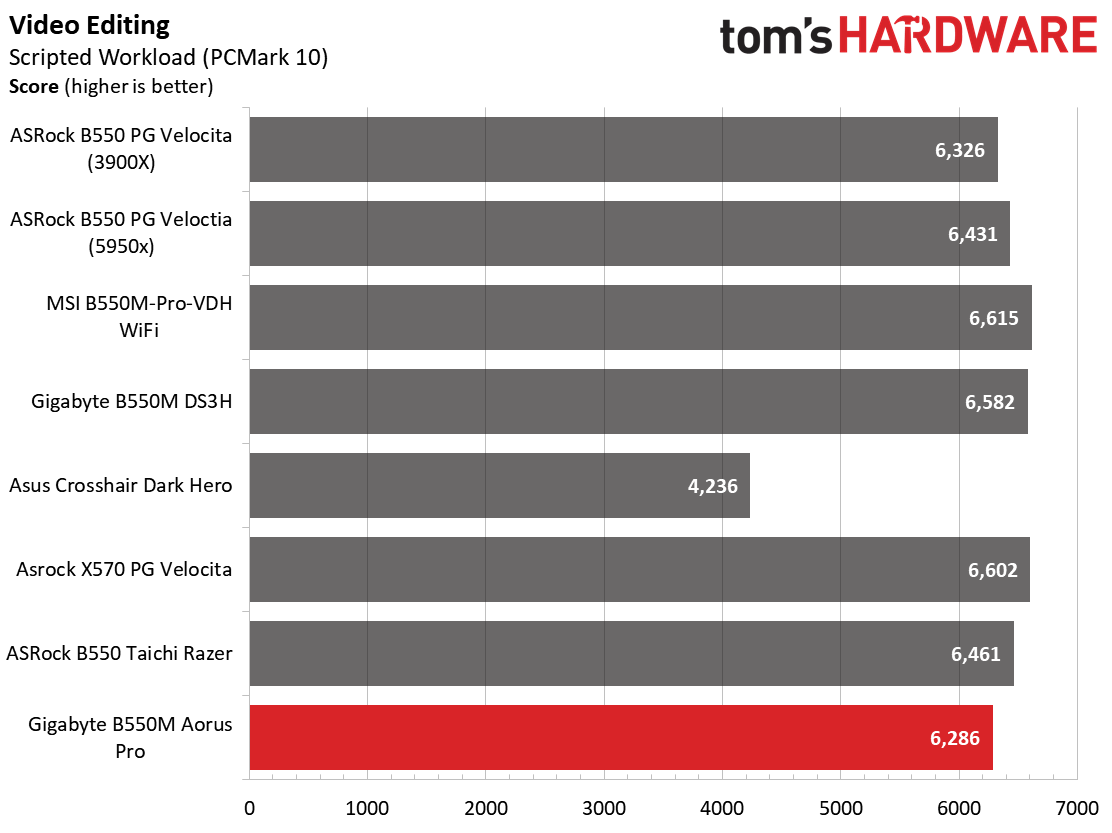









In our synthetic benchmarks, the B550M Aorus Pro did well in most tests, falling right around the other systems we’ve reviewed. We again saw some outliers within the PCMark 10 suite, particularly in Application Startup and Photoshop, but this is more due to PCMark 10 than the motherboard and CPU running slower than it should. 7Zip results were also a bit slower than the rest. Outside of that, there is nothing else to report.
Timed Applications




Moving on to timed applications, our tests showed the Aorus Pro quicker than the average results in Corona and in the middle of the pack LAME results. Handbrake times were a bit slower than the others, but nothing alarming.
3D Games and 3DMark

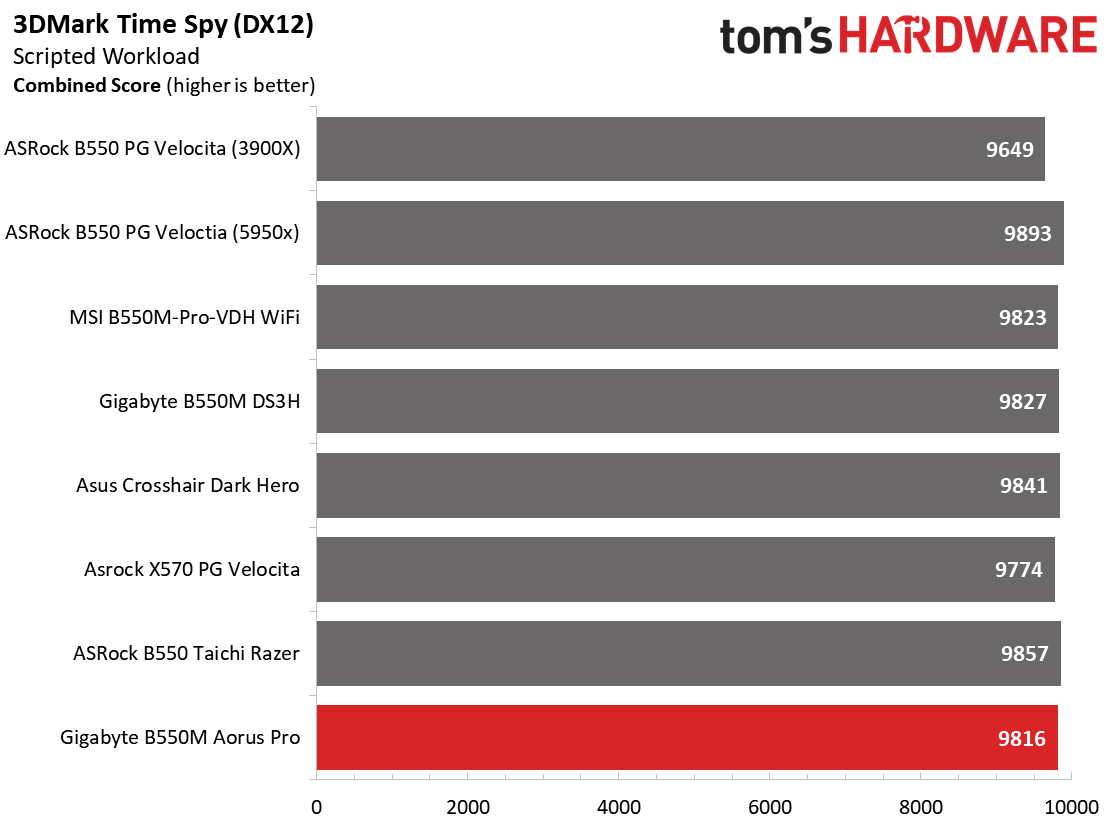


We’ve recently updated our game tests to The Division 2 and Forza Horizon 4. The games are run at 1920x1080 resolution using the Ultra preset. As the resolution goes up, the CPU tends to have less of an impact. The goal with these settings is to determine if there are differences in performance at the most commonly used resolution with settings most people use or at least strive for.
During our gaming tests, we saw appreciable gains when moving from the 3900X to the newer 5950X. Between the clock speeds, IPC and large cache differences, performance increased using this CPU at our 1080p test resolution. If you game at a higher resolution, chances are you won’t see those gains unless you’re using one of the new, ultra-fast Nvidia or AMD GPUs. That out of the way, our B550M Aorus Pro’s results matched that of the other boards we’ve tested so far and is a competent gaming board, as expected.
Power Consumption / VRM Temperatures

For power testing, we used AIDA64’s System Stability Test with Stress CPU, FPU and Cache enabled, using the peak power consumption value. The wattage reading is from the wall via a Kill-A-Watt meter to capture the entire ecosystem. The only variable that changes is the motherboard; all other parts are the same.
Get Tom's Hardware's best news and in-depth reviews, straight to your inbox.
At idle, the B550M Aorus Pro used 78 Watts from the wall. This value is on the high side, but nothing extraordinary. Due in part to the less efficient N-channel MOSFETs, power use peaked at 247 Watts, which is the highest we’ve seen so far. If we average the values out, we’re looking at the most wattage used out of the boards we have tested up to this point, by three Watts. That’s ot a huge deal, but if you’re looking for an efficient motherboard, you’ll want to choose something with better power delivery.




The 13-phase VRM handled our testing with little fanfare, though temperatures did get hot. Our hottest sensor reached almost 80 degrees Celsius During stock runs, the highest value we recorded with this CPU at stock speeds. Hwinfo reported the sensor running even hotter, peaking over 80 degrees Celsius.
After overclocking our Ryzen 9 5950X to 4.4 GHz and 1.3V, VRM temps peaked over 101 degrees Celsius. While this seems hot, and most certainly is, the MOSFETs are specified to handle these temperatures (though not much more). We didn’t see any throttling during testing, so everything went well in this short test. That said, I’m not sure I would run this CPU overclocked, especially if you’re beating on all cores and threads heavily. A 65W CPU and overclocking would be a much better match for the Aorus Pro.
Overclocking
There are several ways to overclock on AMD platforms, depending on your goals. If your focus is single-threaded performance, you may want to focus on using Precision Boost Overdrive (PBO) and adjusting its parameters. If you can use all cores and threads, setting a manual CPU multiplier and voltage is likely the better route. While the latter clips peak single-threaded performance a bit, it increases all core/thread performance over the all-core boost. To that end, we settled on 4.4 GHz at ~1.3V for an all core/thread overclock.
Our Gigabyte B550M Aorus Pro handled our overclocked 16-core/32-thread Ryzen 9 5950X without issue. Although the VRMs were hot, throttling was not a concern in our stress test. To reduce Vdroop, we set the BIOS to the Turbo setting, which yielded a similar load voltage to what was entered in the BIOS.
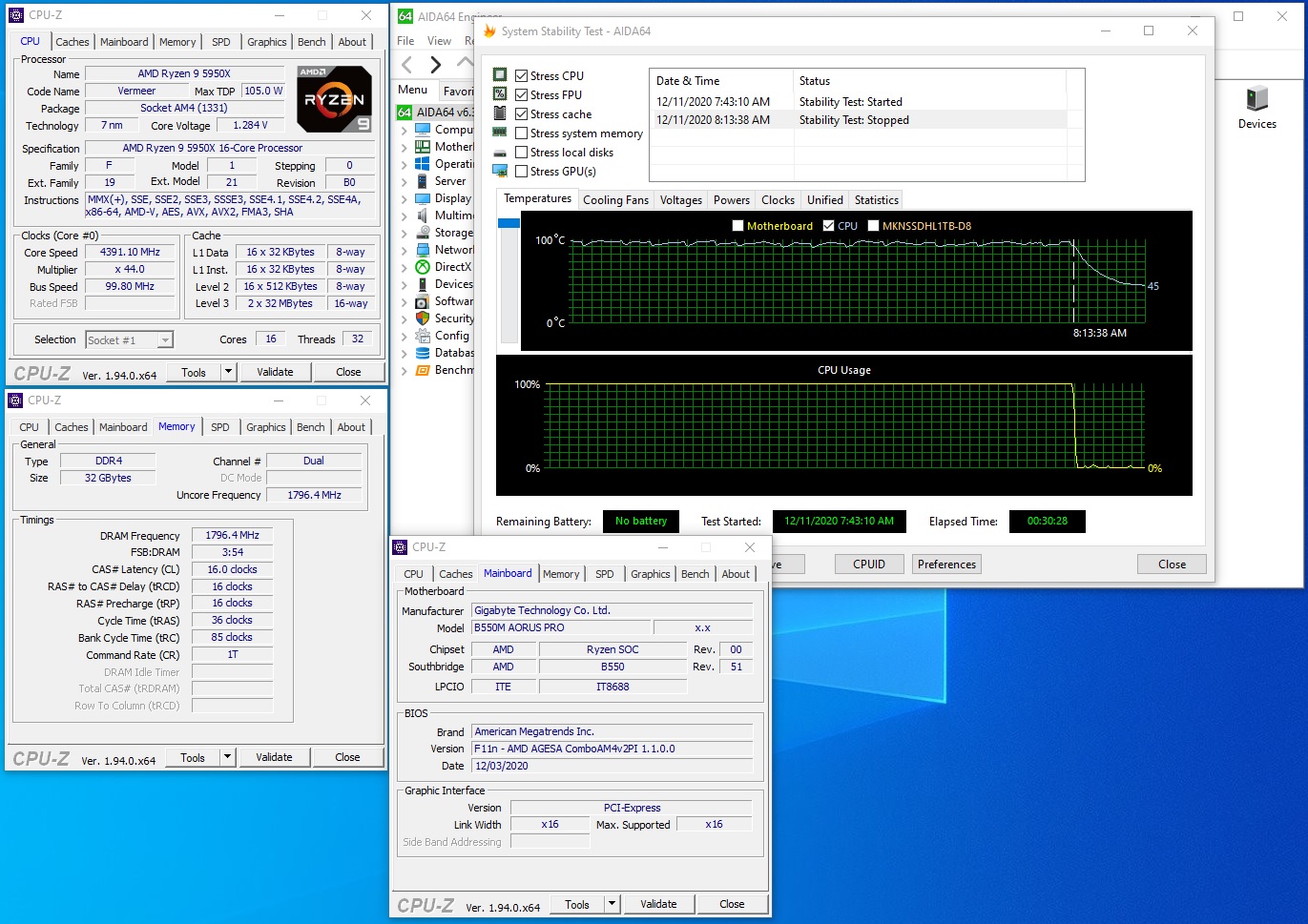
On the memory side, we know AMD is limited to around 3600/3733 MHz when keeping FCLK at a 1:1 ratio to the memory. With this in mind, we add two more sticks and run 4x8GB at DDR4 3600 which is AMD’s current sweet spot for price and performance. We didn’t run into any issues on this board. All we did was to set XMP and we were on our way.
Final Thoughts
Gigabyte’s B550M Aorus Pro turns out to be a solid motherboard to build a MicroATX B550-based system. Priced at $129.99, it offers users four SATA ports, two M.2 sockets, a solid audio section and a whopping 10 USB ports. It handled our power-hungry Ryzen 9 5950X processor at stock speeds and while overclocked, which is impressive for such an inexpensive board. Though if you’re going to overclock any of the 105W chips on the Aorus Pro, you’ll want to add active cooling to the VRMs as they will run hot; theyreached over 100 degrees Celsius in our testing.
I would like to see both M.2 sockets with heatsinks on them, as M.2 are becoming more popular, affordable, and warmer running (especially PCIe 4.0 drives). I also would like to see Wi-Fi more frequently used on this class of motherboard. Of the similarly priced/sized B550 motherboards (MSI MAG B550M Bazooka $125.99, ASRock B550M Steel Legend $150.99, Asus Prime B550M-A Wi-Fi $129.99), only the Asus includes Wi-Fi, though it and the MSI boards have inferior audio sections compared to the Aorus Pro.
Overall, we like what the B550M Aorus Pro has to offer in the midrange MicroATX segment. If you aren’t running more than four SATA hard drives or SSDs and don’t require integrated Wi-Fi (you can add a Wi-Fi card in the spare slot if needed), this board offers users an inexpensive option into a chipset that supports the latest generation AM4 processors. If you’re looking for a MicroATX motherboard covering all of the bases and capable of handling supported flagship AM4 processors, the Gigabyte B550M Aorus Pro is one of the best out there at its size and price point.
MORE: Best Motherboards
MORE: How To Choose A Motherboard
MORE: All Motherboard Content

Joe Shields is a staff writer at Tom’s Hardware. He reviews motherboards and PC components.
-
kyuuketsuki Not sure why the author beats on the "no integrated wi-fi" drum. Desktop systems are largely stationary, and many certainly use ethernet for the network connection rather than wi-fi, as they should. Having the option to purchase a board without a wi-fi chipset, which would be a useless component (and therefore expense), is appreciated. For those do want wi-fi, they can use an add-in card (as noted) or find one of the multitude of boards that does have wi-fi.Reply
Also, having a smaller number of SATA and M.2 slots is par for the course for mATX and mITX boards, isn't it? Not sure that's really a legitimate knock against the board either.
Should also note that there is an updated version of this board, denoted with a -P, that upgrades the ethernet to 2.5Gb and ups the supported RAM speed to DDR4-4400. The audio solution may or may not be different (different model numbers are shown in the Newegg listings). Otherwise it seems identical. -
JamesSneed Replykyuuketsuki said:Not sure why the author beats on the "no integrated wi-fi" drum. Desktop systems are largely stationary, and many certainly use ethernet for the network connection rather than wi-fi, as they should. Having the option to purchase a board without a wi-fi chipset, which would be a useless component (and therefore expense), is appreciated. For those do want wi-fi, they can use an add-in card (as noted) or find one of the multitude of boards that does have wi-fi.
Also, having a smaller number of SATA and M.2 slots is par for the course for mATX and mITX boards, isn't it? Not sure that's really a legitimate knock against the board either.
Should also note that there is an updated version of this board, denoted with a -P, that upgrades the ethernet to 2.5Gb and ups the supported RAM speed to DDR4-4400. The audio solution may or may not be different (different model numbers are shown in the Newegg listings). Otherwise it seems identical.
This was a very lazy review. All of the cons really are not cons for 99% of the people building a mATX build. -
kaalus Why would you want more than 4 SATA ports? 4 is too many already, 2 would be perfectly fine. SATA is legacy anyway, and most people should have their harddrives in a server, not in their desktop. No WiFI? That's a plus. And who needs so many USB ports?Reply
The real minus is lack of 2.5GBps Ethernet - that's rules it out for me. -
agabriel Reply
There's a new one with 2.5GBs B550M AORUS PRO-Pkaalus said:Why would you want more than 4 SATA ports? 4 is too many already, 2 would be perfectly fine. SATA is legacy anyway, and most people should have their harddrives in a server, not in their desktop. No WiFI? That's a plus. And who needs so many USB ports?
The real minus is lack of 2.5GBps Ethernet - that's rules it out for me. -
Rookie_MIB Replykaalus said:Why would you want more than 4 SATA ports? 4 is too many already, 2 would be perfectly fine. SATA is legacy anyway, and most people should have their harddrives in a server, not in their desktop. No WiFI? That's a plus. And who needs so many USB ports?
The real minus is lack of 2.5GBps Ethernet - that's rules it out for me.
Well, with the amount of cores that these higher end builds may have, setting up a small VM for a server is a piece of cake. Why have the expense of a completely separate machine when you can take the one you have, allocate 2 out of 16 cores to it, some ram, and then just add 3 or 4 large HDDs for your server.
Personally, 4 SATA ports is just about perfect. 1 NVME M.2 port for the boot drive, 1 SATA for large storage for the main machine and 3 SATA for the VM server. Or, just put all 4 SATAs to the VM and map the large storage for the main system to the server. It would almost be as fast as local storage.
And yes, I do agree with the 2.5G ethernet. These days many people are looking for more than your typical 1Gb networking. Still, the board looks pretty solid otherwise. -
Late_Apex ReplyAdmin said:The MicroATX B550M Aorus Pro performed well in our tests and even managed to overclock the Ryzen 9 5950X. The $129.99 board is a step up from the DS3H, including more robust power delivery, improved audio, a heatsink for an M.2 module, and more.
Gigabyte B550M Aorus Pro Review: Reasonably Priced, Capable MicroATX : Read more
why no comments about the b550 usb bug that is particularly bad with gigabyte b550 boards? Having your USB port drop out randomly is somewhat of a major con. Did gigabyte manage to fix that for this board? Last I looked yesterday they were still waiting for a fix from amd (for a similar board). -
neojack Replykyuuketsuki said:Not sure why the author beats on the "no integrated wi-fi" drum. Desktop systems are largely stationary, and many certainly use ethernet for the network connection rather than wi-fi, as they should.
You are right, but integrated wifi comes with integrated bluetooth, Wich is needed for VR.
Since VR already uses a lot of USB ports, and this motherboard has limited PCIe extentions, that make sense to mention it, but not the way it was in the article.